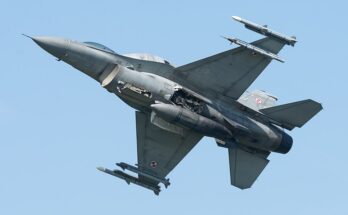As had been widely expected Belgium has tapped the next-generation F-35 Lightning II combat aircraft from Lockheed Martin as its preferred alternative to replace the Belgian Air Force’ legacy fleet of F-16s. National news outlet Belga leaked news of the decision days earlier, but confirmation came on October 25 from Defense Minister Steven Vandeput by way of Twitter.
We zijn geland! Deze regering investeert fors in Defensie. Met de aankoop van F-35A gevechtsvliegtuigen, landvoertuigen en verkenningsdrones verzekeren we uw veiligheid én die van onze militairen @BelgiumDefence #veiligheid
— Steven Vandeput (@svandeput) October 25, 2018
An F-16 replacement program was spelled out under Belgium’s long-term defense planning paper, the Strategic Plan 2030, which was unveiled in 2015. The replacement program calls for the purchase of 34 multirole combat aircraft to replace the F-16s. A formal selection process was launched by the Belgian government on March 17, 2017, with the goal of making a down-selection in 2018 that would lead to entry into service by 2023, basic operational capability to conduct quick reaction alert duties in 2025, followed by full operational capability in 2030.
Requests for proposals (RFPs) were sent out the U.S. Joint Program Office regarding the F-35A, the U.S. Navy program manager for the Boeing F/A-18E/F Super Hornet, France’s DGA procurement agency regarding the Dassault Rafale, the U.K. Defense Ministry regarding the Eurofighter Typhoon, and to the Swedish FMV for the Saab Gripen E.
Citing an unfair advantage for the F-35A, Boeing opted to withdraw from the competition.
Saab then withdrew its Gripen E for what it deemed “political reasons” (ostensibly related to Belgium’s hosting of the NATO strategic deterrent, which are tactical nuclear weapons in the form of air-delivered B61 gravity bombs).
The status of the Rafale remained in question as a formal offer was never forthcoming from France, which instead proposed a “structural partnership” in the form of a larger EUR20 billion co-operational package involving hardware beyond just the Rafale fighter.
On September 7, 2017, the Belgian Ministry of Defense received two governmental offers for fighter sales, one from the U.K. for the Typhoon and one from the U.S. for the F-35A.
By January 19, 2018, the U.S. government had cleared the way for an intergovernmental sale of 34 F-35As to Belgium along with 38 Pratt & Whitney F-135 engines, altogether estimated at $6.53 billion.
This was followed on February 14, 2018, by Belgium stating that it had received Best and Final offers from Britain and the U.S. for the two aforementioned platforms, thus launching the evaluation phase of the competition.
Belgium expects the service lives of its fleet of F-16s – acquired in the 1980s as a replacement for the Air Force’ fleet of F-104s and Mirage 5s – to expire around the mid-to-late 2020s. The Belgian F-16s were produced under license by Belgian aerospace companies SABCA/SONACA.
The deciding factors for Belgium not only involved the advanced characteristics of the F-35, but concerns over being able to certify a European fighter alternative for the carrying of U.S. nuclear weapons in the event of a hypothetical atomic conflict (as per a decades-old agreement between Belgium and NATO) and inter-operability with neighboring Netherlands with whom Belgium shares joint policing of a common airspace under the Benelux arrangement. Furthermore, the F-35 offers the smoothest possible transition for F-16 operators as it was designed as a replacement for the “Fighting Falcon”.
Of greater interest is how this impacts the European slice of the global fighter market and French-German ambitions for reshaping defense solutions across Europe in an effort to reduce dependence upon American weapons solutions. With Belgium a dual EU-NATO member and supporter of pan-EU defense integration and broader European defense initiatives its selection of a U.S.-sourced fighter will dampen the impact of a nascent French-German Future Combat Air System (FCAS) project announced by the defense ministers of both countries at the ILA Airshow in Berlin on April 26, 2018.
Dan Darling is Forecast International’s director of military and defense markets. In this role, Dan oversees a team of analysts tasked with covering everything from budgeting to weapons systems to defense electronics and military aerospace. Additionally, for over 17 years Dan has, at various times, authored the International Military Markets reports for Europe, Eurasia, the Middle East and the Asia-Pacific region.
Dan's work has been cited in Defense News, Real Clear Defense, Asian Military Review, Al Jazeera, and Financial Express, among others, and he has also contributed commentary to The Diplomat, The National Interest and World Politics Review. He has been quoted in Arabian Business, the Financial Times, Flight International, The New York Times, Bloomberg and National Defense Magazine.
In addition, Dan has made guest appearances on the online radio show Midrats and on The Media Line, as well as The Red Line Podcast, plus media appearances on France 24 and World Is One News (WION).




